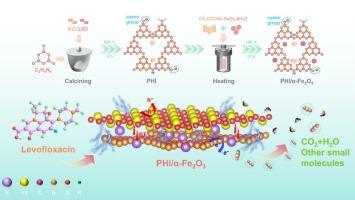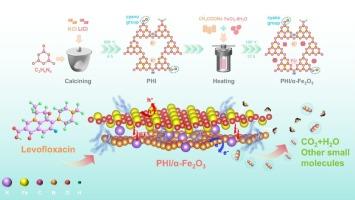Fe-N配位驱动Z-scheme管状聚(庚嗪亚胺)/α-Fe2O3异质结改善左氧氟沙星光催化降解
IF 9
1区 工程技术
Q1 ENGINEERING, CHEMICAL
引用次数: 0
摘要
聚七嗪亚胺盐(PHI)是一种晶体氮化碳化合物,对左氧氟沙星的降解具有显著的光催化活性,但光生成的载流子重组迅速。本研究制备了一种直接Z-scheme管状聚(heptazine亚胺)/赤铁矿(PHI/α-Fe2O3)异质结,其内部电场(IEF)被设计成有效抑制光生载流子重组。管状PHI增强了电子传递,z型异质结结构提供了有效的电荷转移途径。α-Fe2O3导带中的光生电子在IEF的影响下通过Fe-N配位键迁移到PHI的价带,并与空穴复合。这种机制有效地抑制了光产生的电荷重组,同时维持了足够的氧化还原势,以形成•O2 - /•OH。在模拟阳光下,PHI/Fe-3复合材料在60 min内对左氧氟沙星的降解率高达99.13 %,降解速度达到PHI的7.6倍。理论计算和实验表征的协同作用阐明了PHI/α-Fe2O3中有效载流子的电荷转移途径和分离机制。本研究介绍了一种制备具有优异光催化性能的磷酸基光催化材料的新方法。本文章由计算机程序翻译,如有差异,请以英文原文为准。


Fe–N coordination-driven Z-scheme tubular poly(heptazine imide)/α-Fe2O3 heterojunction to improve photocatalytic degradation of levofloxacin
Poly(heptazine imides) (PHI) salts, a crystalline carbon nitride compound, exhibit significant photocatalytic activity for levofloxacin degradation, but photogenerated charge carriers recombine rapidly. A direct Z-scheme tubular poly(heptazine imides)/hematite (PHI/α-Fe2O3) heterojunction is fabricated in this study, with an internal electric field (IEF) engineered to effectively inhibit photogenerated charge carrier recombination. Tubular PHI enhances electron transport, and Z-scheme heterojunction structure provides an efficient charge transfer pathway. Photogenerated electrons in the α-Fe2O3 conduction band migrate to the valence band of PHI under the influence of the IEF through the Fe-N coordination bond, where they recombine with holes. This mechanism effectively suppresses photogenerated charge recombination while sustaining a redox potential thermodynamically sufficient for •O2–/•OH formation. PHI/Fe-3 composite achieves a levofloxacin degradation rate of up to 99.13 % within 60 min in simulated sunlight, and its degradation speed can reach 7.6 times that of PHI. A synergy of theoretical calculations and experimental characterizations elucidates the charge transfer pathway and the separation mechanism of efficient charge carrier in PHI/α-Fe2O3. This study introduces a new approach for manufacturing PHI-based photocatalytic materials with superior photocatalytic performance.
求助全文
通过发布文献求助,成功后即可免费获取论文全文。
去求助
来源期刊

Separation and Purification Technology
工程技术-工程:化工
CiteScore
14.00
自引率
12.80%
发文量
2347
审稿时长
43 days
期刊介绍:
Separation and Purification Technology is a premier journal committed to sharing innovative methods for separation and purification in chemical and environmental engineering, encompassing both homogeneous solutions and heterogeneous mixtures. Our scope includes the separation and/or purification of liquids, vapors, and gases, as well as carbon capture and separation techniques. However, it's important to note that methods solely intended for analytical purposes are not within the scope of the journal. Additionally, disciplines such as soil science, polymer science, and metallurgy fall outside the purview of Separation and Purification Technology. Join us in advancing the field of separation and purification methods for sustainable solutions in chemical and environmental engineering.
 求助内容:
求助内容: 应助结果提醒方式:
应助结果提醒方式:


